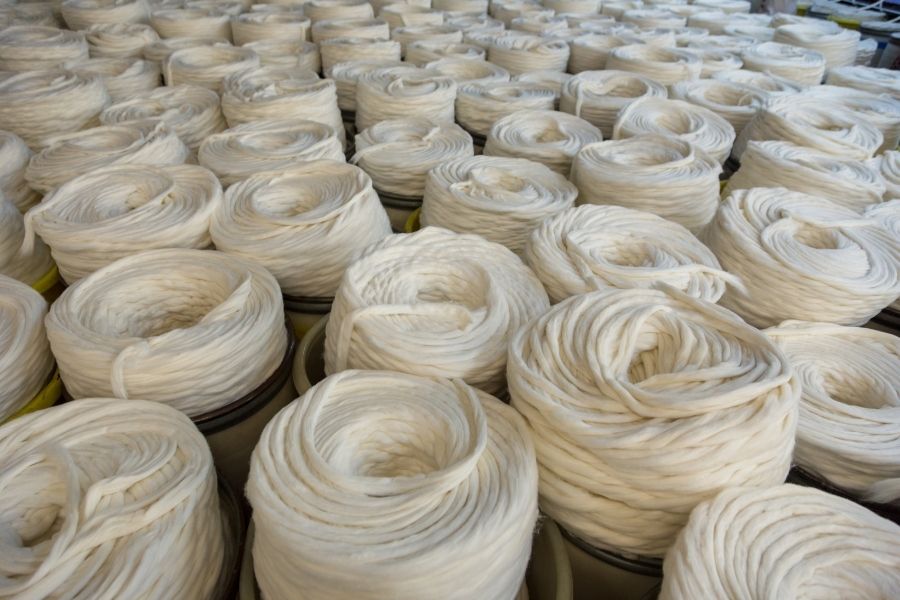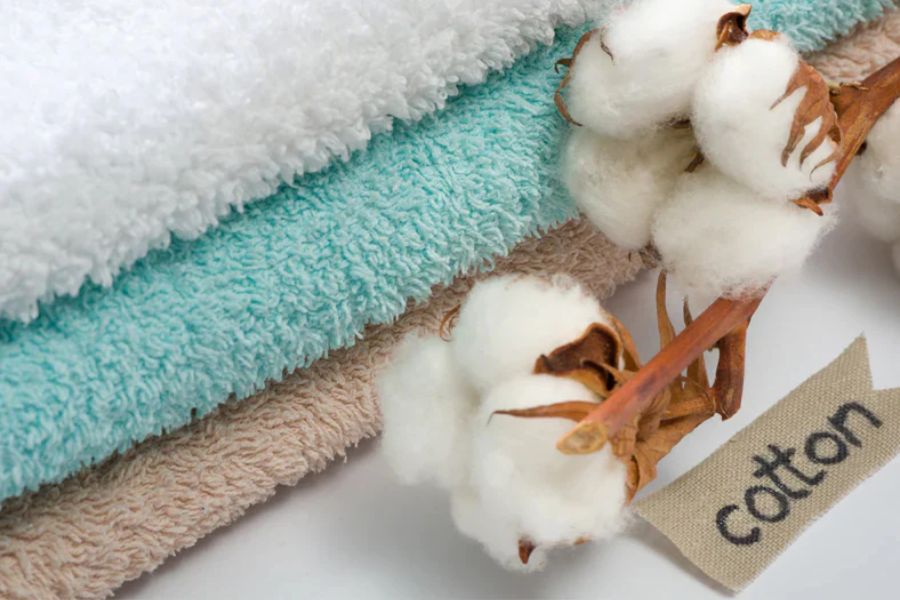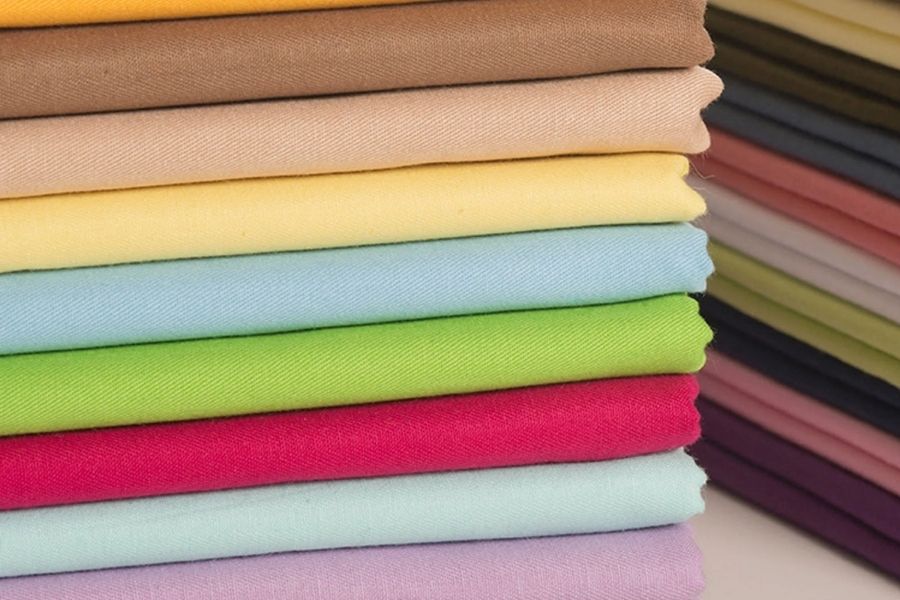
What is Recycled Cotton? Is Recycled Cotton Sustainable?
Key Takeaways
- Is cotton recyclable? Yes, and even better. Find out more about its perks and start making choices to protect our environment.
- It’s not hard to start recycling. 7 steps on how to recycle cotton clothes are waiting for you to discover!
- Join the movement! As technology advances and awareness spreads, find out how recycled cotton is paving the way for a brighter future.
What is Recycled Cotton?
Recycled cotton is exactly what it sounds like – cotton that's been recycled. Instead of growing new cotton, taking a lot of water and energy in the process, we take fibers from stuff that’s already been made and turn them into new clothes. That's the magic of recycled cotton in the world of eco-friendly fashion!
Types of Recycled Cotton
Pre-consumer Recycled Cotton

Recycling cotton from manufacturing scraps
The name says it all. This type comes from the scraps and leftovers from manufacturing before consumers get their hands on the items.
During cutting and sewing, not all of the cotton makes it into the final product, such as:
- Yarn waste from spinning mills
- Fabric scraps from cutting rooms
- Leftover material from overproduction
- Quality control rejects that didn't make the cut
These bits and pieces, usually ending up in the trash, are collected, sorted, and turned into new fibers.
Post-consumer Recycled Cotton

Used cotton clothes
Then there’s post-consumer recycled cotton made from old clothes and linens. Your old favorite t-shirt, those jeans that no longer fit, or the threadbare sheets you've finally replaced… All of these can be good ingredients for it.
Since we have the ingredients down, it is time for a step-by-step tutorial:
- Step 1: Used clothes are gathered through donation bins, thrift stores, or textile recycling programs.
- Step 2: They’re separated by color and material and then thoroughly cleaned to remove any dirt or contaminants.
- Step 3: The clean fabric is then processed back into fiber form. These fibers are often mixed with virgin cotton or other materials to improve strength and quality.
- Step 4: The new fibers are spun into new yarn, ready to be woven or knitted into new products.
These two babes represent different points in the cotton lifecycle where we can step in, sprinkle some fairy dust, and reduce waste while also making the most of our resources. Both of these are a fantastic way to make a positive impact, by the way.
It’s a simple change we can all make to help make the fashion industry a little kinder to the planet!
Advantages & Disadvantages of Recycled Cotton
Benefits
Environmental Impact
Some estimations suggest that recycled cotton can save up to 20,000 liters of water per kilogram versus virgin cotton. That's enough to fill a small swimming pool!
Therefore, by using recycled materials, we need less virgin cotton, aka a resource-hungry crop. Meaning? More water, energy, and land for our precious Mother Nature to do her thing without too much interference.
Resource Efficiency
Virgin cotton production often involves heavy water and pesticide use, which makes this material a real resource hog. Recycled cotton? Not so much.
It's a smart way to make the most of what we already have instead of constantly extracting new materials from the earth. This shift not only conserves valuable resources but also challenges our consumer habits. We’re replacing the wasteful "buy, wear, toss" cycle with a more thoughtful "use, reuse, repeat" model.
Fashion doesn't have to come at such a high environmental cost at all!
Economic Benefits
Recycling cotton can be a smart business move, too.
Manufacturers can slash production costs by using waste products instead of starting from scratch. It's a domino effect of benefits: businesses save money, shoppers get better deals, and the environment catches a break.

Leftovers to create recycled cotton
When more and more companies adopt this mindset, it could drive innovation in recycling technologies and create new jobs in the circular economy. What's good for the Earth can also be good for the wallet if you know how to balance things out.
Conscious Consumer Magnet
With the rise in eco-friendly choices, recycled cotton is becoming a common option. Brands that embrace recycled materials are making a statement. They’re naturally drawing in a growing segment of shoppers who vote with their wallets for a greener future, much like you who’s reading this article!
It's creating a positive feedback loop: more demand for recycled materials equals more interest in funding recycling technologies and sustainable supply chains. That’s to say, your contribution means something, no matter how small.
Drawbacks
Quality Concerns
The fibers might not be as strong or durable as those from virgin cotton. Manufacturers sometimes tackle this problem by blending recycled cotton with virgin cotton or other materials. But then, that wouldn’t be so much recycling as we wanted, would it?
All in all, recycled cotton can be a great choice, but don’t be too trusty and check the quality of those items before buying. Sometimes it works great, sometimes, it's a bit wobbly.

Quality check before buying recycled cotton clothes
Limited Availability
Finding recycled cotton isn't that easy, as you can't grow it on demand. Its availability can be hit or miss because it depends on how much scrap material and used clothing are collected.
Many places are still catching up to the recycling game, so we need more proper infrastructure to gather and process old textiles efficiently, too. So while the idea is golden, the reality is a bit more patchy. Shall we say it's patchy?
Cost Implications
Although recycled cotton can save money for manufacturers in some ways, it costs more in others. Sorting, cleaning, and processing the cotton takes extra work and resources. Sometimes, these costs trickle down to the price tag. But hopefully, it’s not about the money, money, money for you.
Color and Consistency
It’s not the easiest task to get an even color palette. You're dealing with a mishmash of fibers from various sources, each with its own dye history and personality quirks. This chaos can give designers a real headache as it limits their choices and forces them to go out of their way to nail that perfect shade.
Unless… messy aesthetics is your thing.
How to Recycle Cotton
This is how to recycle cotton in 7 easy steps:
- Sort it out: First things first, gather all the cotton stuff that you want to recycle. Check the tags to see if they’re 100% cotton or mostly cotton. Make sure to separate them from other fabrics like polyester or wool. Recycling centers will be very thankful.
- Find your spot: Look for local recycling programs or textile recycling bins in your area. Many cities have drop-off points where you can leave your old cotton clothes. Even better, some cool brands have take-back programs that you send back your old stuff for recycling.
- Donate or upcycle: Local charities or thrift stores would love to give your used cotton clothes a second chance. This way, someone else can enjoy them, and you're still keeping them out of the landfill.

Cotton clothes donation
- DIY recycling: You can always try this at home if you don’t mind the extra labor. Turn worn-out jeans into a funky patchwork tote bag. Slice faded t-shirts into strips and crochet a colorful rug. Even those holey socks can become draft stoppers for doors and windows. With a little imagination, your old cotton can skip the landfill.
- Shop smart: Next time you’re shopping, support brands that use recycled cotton in their products. You’re one step closer to backing sustainable practices and ending the loop in the fashion industry.
- Spread the word: Share your recycling journey with friends, family, and even strangers online. The more people know how to recycle cotton, the bigger the impact we can make. Encourage them to join in and make recycling part of their lifestyle as well.
Even worn-out or damaged cotton items can be recycled. It’s the more reason you shouldn’t let anything go to waste. In the grand cosmos of recycling, every little bit counts!
Where to Buy Recycled Cotton
Eco-Friendly Brands
Many brands are hopping on the green train and offering stylish recycled cotton options. Take a look at eco-conscious brands like Patagonia, Everlane, Tentree, or us, hi there! They are well-known for their dedication to sustainability, and they provide a variety of recycled cotton goods that are both stylish and planet-friendly.

Vegan Comic Universe commits to sustainable fashion
But don’t just take our word for it. Check for certifications like Global Recycled Standard (GRS) or Recycled Claim Standard (RCS) to ensure the recycled materials are truly “recycled.”
Online Marketplaces
Platforms like Etsy often feature indie sellers offering unique recycled cotton items. From hand-crafted clothing to eco-friendly home decor, you'll find a universe of options. It's a great way to support small businesses and simultaneously make sustainable choices. Take that pollution!

Support small shops on Etsy
Thrift Stores and Vintage Shops
Many thrift stores sort items by material, so finding cotton garments should be a piece of cake. Look for high-quality, durable cotton items that can stand multiple wears.
Buying second-hand extends a garment's lifecycle by an average of 2.2 years, which is shocking! Plus, you're likely to find affordable, one-of-a-kind styles that aren't available in mainstream stores. Being an alt and environmentally conscious girl isn’t that hard after all.
Local Boutiques
These local cosmic outposts often have direct contact with sustainable designers and manufacturers. Worry not because they will ensure the quality and authenticity of their recycled cotton products for you.
You get to support your community's economy and reduce transportation emissions by shopping near your house. The owners can also give you decent styling advice and detailed info about the origins and production of each item. Everyone has something they can offer, especially people with years-long experience in the field.

Buy from local shops to decrease pollution
Sustainable Fashion Events
These gatherings often invite brands and designers to talk about their work. You can chat with them to learn about sustainable practices and their backstories. These events also usually host workshops and talks. Get your advice on introducing recycled cotton into your wardrobe there!
It’s a fun way to explore new knowledge, and you get to meet like-minded people who care about the environment as a bonus.
FAQs
How to recycle cotton clothes?
Recycling cotton clothes is easy! Just find a local recycling bin or program, or donate them to a thrift store. Also, you can always recycle them into something new and fun at home.
Can cotton be recycled?
Totally! Cotton can be recycled by turning old fabrics into fresh fibers for new yarns. That goes for both pre-consumer (manufacturing scraps) and post-consumer (used garments) cotton.
Is recycled cotton sustainable?
You bet! Recycled cotton is generally more sustainable than virgin cotton. It reduces waste, saves water, and lowers carbon emissions.
Despite there being some challenges in production and quality, its positive environmental impact makes it worth the effort. In the current context of tech advancements, recycled cotton is becoming an increasingly viable and eco-friendly option.



